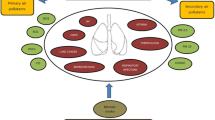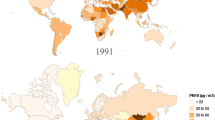Abstract
Fungal spores of Alternaria and Cladosporium are ubiquitous components of both indoor and outdoor air samples and are the main causes of human respiratory allergies. Monitoring these airborne fungal spores during 2009–2014 was carried out by means of Hirst-type spore trap to investigate their airborne spore concentrations with respect to annual load, seasonality and overall intradiurnal pattern. Alternaria and Cladosporium spores are present throughout the year in the atmosphere of Tétouan, although they show seasonal variations. Despite important differences between years, their highest levels presented a first peak during spring and a higher second peak in summer or autumn depending on the year. The spore concentrations were homogeneously distributed throughout the day with slight increase of 7.6 and 3.7% on average between 12–14 and 14–16 h for Alternaria and Cladosporium, respectively. The borderline of 3000 sp/m3 of Cladosporium linked to the occurrence of allergic diseases was exceeded between 13 and 31 days. Airborne spores of Alternaria overcame the threshold value of 100 sp/m3 up to 95 days, suggesting that Cladosporium and Alternaria could be clinically significant aeroallergens for atopic patients.




Similar content being viewed by others
References
Adhikari, A., Sen, M. M., Gupta-Bhattacharya, S., & Chanda, S. (2004). Airborne viable, non-viable, and allergenic fungi in a rural agricultural area of India: A 2-year study at five outdoor sampling stations. Sciences of the Total Environment, 326, 123–141.
Aira, M. J., Rodríguez-Rajo, F. J., & Jato, V. (2008). 47 Annual records of allergenic fungi spore: Predictive models from the NW Iberian Peninsula. Annals of Agricultural and Environmental Medicine, 15, 91–98.
Bardei, F., Bouziane, H., Kadiri, M., Rkiek, B., Tebay, A., & Saoud, A. (2016). Profils de sensibilisation cutanée aux allergènes respiratoires des patients de la ville de Tétouan (Nord Ouest du Maroc). Revue de Pneumologie Clinique, 72(4), 221–227.
Bardei, F., Bouziane, H., Trigo, M. M., Ajouray, N., El Haskouri, F., Filali Ben Sidel, F., et al. (2013). Incidence des spores fongiques de l’air de Tétouan (NW du Maroc) et influence des paramètres météorologiques. Revue Française d’Allergologie, 53, 576–584.
Bouziane, H., Latgé, J. P., & Lelong, M. (2006). Immunochemical comparison of the allergenic potency of spores and mycelium of Cladosporium cladosporioides extracts by electroblotting technique. Allergologia et Immunopathologia, 34(2), 64–69.
De Linares, C., Belmonte, J., Canela, M., De la Guardia, C. D., Alba-Sanchez, F., Sabariego, S., et al. (2010). Dispersal patterns of Alternaria conidia in Spain. Agricultural and Forest Meteorology, 150, 1491–1500.
Domsch, K., Gams, W., & Anderson, T. H. (1993). Compendium of soil fungi. Germany: IHW.
El Haskouri, F., Bouziane, H., Trigo, M. M., Kadiri, M., & Kazzaz, M. (2016). Airborne ascospores in Tétouan (NW Morocco) and meteorological parameters. Aerobiologia,. doi:10.1007/s10453-016-9440-8.
El Mrini, A., Nachite, D., & Taaouati, M. (2008). Interactions physico-naturelles et socio-economiques sur le littoral Tétouanais (Maroc Nord Occidental). In Actes du colloque international pluridisciplinaire “le littoral: subir, dire, agir”, Lille, France, janvier 16–18, 2008.
Filali Ben Sidel, F., Bouziane, H., Trigo, M. M., Haskouri, F., Bardei, F., Redouane, A., et al. (2015). Airborne fungal spores of Alternaria, meteorological parameters and predicting variables. International Journal of Biometeorology, 59, 339–346.
Galán, C., Cariñanos, P., Alcázar, P., & Dominguez-Vilches, E. (2007). Spanish Aerobiology Network (REA): Management and quality manual. Córdoba: Ed. Servicio de publicaciones de la universidad de Cordoba.
Galán, C., Tormo, R., Cuevas, J., Infante, F., & Dominguez, E. (1991). Theoretical daily variation patterns of airborne pollen in the southwest of Spain. Grana, 30, 201–209.
Gargouri, I., Mezghani, S., Hayouni, A., Njima, H., Abdelghani, A., Garrouch, A., et al. (2010). Recensement des spores fongiques de l’atmosphère de la ville de Sousse (Tunisie). Revue Française d’Allergologie, 50, 603–610.
Hasnain, S. M., Al-Frayh, A. S., Al-Suwaine, A., Gad-El-Rab, M. O., Fatima, K., & Al-Sedairy, S. (2004). Cladosporium and respiratory allergy: Diagnostic implications in Saudi Arabia. Mycopathologia, 157, 171–179.
Hirst, J. M. (1952). An automatic volumetric spore trap. Annals of Applied Biology, 39, 257–265.
Jacob, B., Ritz, B., Gehring, U., Koch, A., Bischof, W., Wichmann, H. E., et al. (2002). Indoor exposure to molds and allergic sensitization. Environmental Health Perspectives, 110(7), 647–653.
Jones, A., & Harrison, R. (2004). The effects of meteorological factors on atmospheric bioaerosol concentrations. Sciences of the Total Environment, 326, 151–180.
Levetin, L. (2004). An atlas of fungal spores. Journal of Allergy and Clinical Immunology, 113, 366–368.
Nilsson, S., & Persson, S. (1981). Tree pollen spectra in the Stockholm region (Sweden), 1973–1980. Grana, 20, 179–182.
Oliveira, M., Ribeiro, H., Delgado, J., & Abreu, I. (2009). Seasonal and intradiurnal variation of allergenic fungal spores in urban and rural areas of the North of Portugal. Aerobiologia, 25, 85–98.
Oliveira, M., Ribeiro, H., Delgado, L., Fonseca, J., Castel-Branco, M. G., & Abreu, I. (2010). Outdoor allergenic fungal spores: Comparison between an urban and a rural area in northern Portugal. Journal of Investigational Allergology and Clinical Immunology, 20(2), 117–128.
Peternel, R., Čuling, J., & Hrga, I. (2004). Atmospheric concentrations of Cladosporium spp. and Alternaria spp. spores in Zagreb (Croatia) and effects of some meteological factors. Annals of Agricultural Environment and Medicine, 11, 303–307.
Recio, M., Trigo, M. M., Docampo, S., Melgar, M., Garcia-Sánchez, J., Bootello, L. et al. (2012). Analysis of the predicting variables for daily and weekly fluctuations of two airborne fungal spores: Alternaria and Cladosporium. International Journal of Biometeorology, 56(6), 983–991.
Ricci, S., Bruni, M., Meriggi, R., & Corsico, R. (1995). Aerobiological monitoring of Alternaria fungal spores: a comparision between surveys in 1992 and 1993 and local meteorological conditions. Aerobiologia, 11, 195–1999.
Rodriguez-Rajo, F. J., Iglesias, I., & Jato, V. (2005). Variation assessment of airborne Alternaria and Cladosporium spores at different bioclimatical conditions. Mycological Researches, 109(P.t 4), 497–507.
Skjøth, C. A., Sommer, J., Frederiksen, L., & Gosewinkel Karlson, U. (2012). Crop harvest in Central Europe causes episodes of high airborne Alternaria spore concentrations in Copenhagen. Atmospheric Chemistry and Physics, 12, 14329–14361.
Stark, P. C., Celedon, J. C., Chew, G. L., Ryan, L. M., Burge, H. A., Muilenberg, M. L., et al. (2005). Fungal levels in the home and allergic rhinitis by 5 years of age. Environmental Health Perspectives, 113(10), 1405–1409.
Thibaudon, M., & Lachasse, C. (2006). Alternaria, Cladosporium: Dispersion atmosphérique, rythmes nycthéméral et saisonnier. Revue française d’allergologie et d’immunologie clinique, 46, 188–196.
Trigo, M. M., Recio, M., Toro, F. J., & Cabezudo, B. (1997). Intradiurnal fluctuation in airborne pollen in Malaga (S. Spain): A quantitative method. Grana, 36, 39–43.
Zahlane, K., Sahnoune, I., Boukachabine, Kh, & Agoumi, A. (2008). Approche d’une biocontamination fongique en milieu hospitalier Enquête transversale effectuée au niveau du service de réanimation néonatale. Revue de Microbiologie Industrielle, Sanitaire et Environnementale, 2(1), 23–34.
Author information
Authors and Affiliations
Corresponding author
Rights and permissions
About this article
Cite this article
Bardei, F., Bouziane, H., Trigo, M.M. et al. Atmospheric concentrations and intradiurnal pattern of Alternaria and Cladosporium conidia in Tétouan (NW of Morocco). Aerobiologia 33, 221–228 (2017). https://doi.org/10.1007/s10453-016-9465-z
Received:
Accepted:
Published:
Issue Date:
DOI: https://doi.org/10.1007/s10453-016-9465-z




